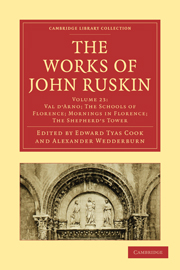Book contents
- Frontmatter
- Contents
- LIST OF ILLUSTRATIONS
- INTRODUCTION TO THIS VOLUME
- NOTE ON PLATE B
- I VAL D'ARNO: TEN LECTURES ON TUSCAN ART DIRECTLY ANTECEDENT TO THE FLORENTINE YEAR OF VICTORIES, GIVEN BEFORE THE UNIVERSITY OF OXFORD IN MICHAELMAS TERM, 1873
- II THE ÆSTHETIC AND MATHEMATIC SCHOOLS OF ART IN FLORENCE: LECTURES GIVEN BEFORE THE UNIVERSITY OF OXFORD IN MICHAELMAS TERM, 1874
- BIBLIOGRAPHICAL NOTE
- SYNOPSIS
- LECTURES
- III MORNINGS IN FLORENCE: BEING SIMPLE STUDIES OF CHRISTIAN ART FOR ENGLISH TRAVELLERS (1875–1877)
- IV THE SHEPHERD'S TOWER (1881): THE SCULPTURES OF GIOTTO'S TOWER, TO ILLUSTRATE “MORNINGS IN FLORENCE”
- APPENDIX
- Plate section
LECTURES
Published online by Cambridge University Press: 07 September 2011
- Frontmatter
- Contents
- LIST OF ILLUSTRATIONS
- INTRODUCTION TO THIS VOLUME
- NOTE ON PLATE B
- I VAL D'ARNO: TEN LECTURES ON TUSCAN ART DIRECTLY ANTECEDENT TO THE FLORENTINE YEAR OF VICTORIES, GIVEN BEFORE THE UNIVERSITY OF OXFORD IN MICHAELMAS TERM, 1873
- II THE ÆSTHETIC AND MATHEMATIC SCHOOLS OF ART IN FLORENCE: LECTURES GIVEN BEFORE THE UNIVERSITY OF OXFORD IN MICHAELMAS TERM, 1874
- BIBLIOGRAPHICAL NOTE
- SYNOPSIS
- LECTURES
- III MORNINGS IN FLORENCE: BEING SIMPLE STUDIES OF CHRISTIAN ART FOR ENGLISH TRAVELLERS (1875–1877)
- IV THE SHEPHERD'S TOWER (1881): THE SCULPTURES OF GIOTTO'S TOWER, TO ILLUSTRATE “MORNINGS IN FLORENCE”
- APPENDIX
- Plate section
Summary
LECTURE I
ARNOLFO
1. In my former lectures I broadly stated to you that the Northern savage art, which I generally called Norman, and the Southern savage art, which I generally called Byzantine, met in Florence, and then became Christian.
This blending of arts took place in the thirteenth century, and formed, about the year 1300, the perfect Christian school of art in Florence. That Christian school by its vivid virtue and exercised senses was enabled to discern right from wrong, and beautiful from base, with precision never before or since reached by the conscience or intellect of man. I have called it, in the references made to it in this course of lectures, the Æsthetic School of Florence, meaning that which had, by reason of use, its senses exercised to the discernment of good from evil.
Diminishing gradually in the faith which was to it more than sight, and adding only to it mathematic science and practical skill, this Florentine power became, about the year 1400, dextrous in the representation of all natural objects—chiefly the body of man—to a degree which had not been seen in art since the best days of Greece. This school of scientific form, culminating in Michael Angelo, I have for present reference called the Mathematic School of Florence.
- Type
- Chapter
- Information
- The Works of John Ruskin , pp. 185 - 280Publisher: Cambridge University PressPrint publication year: 2010First published in: 1906

